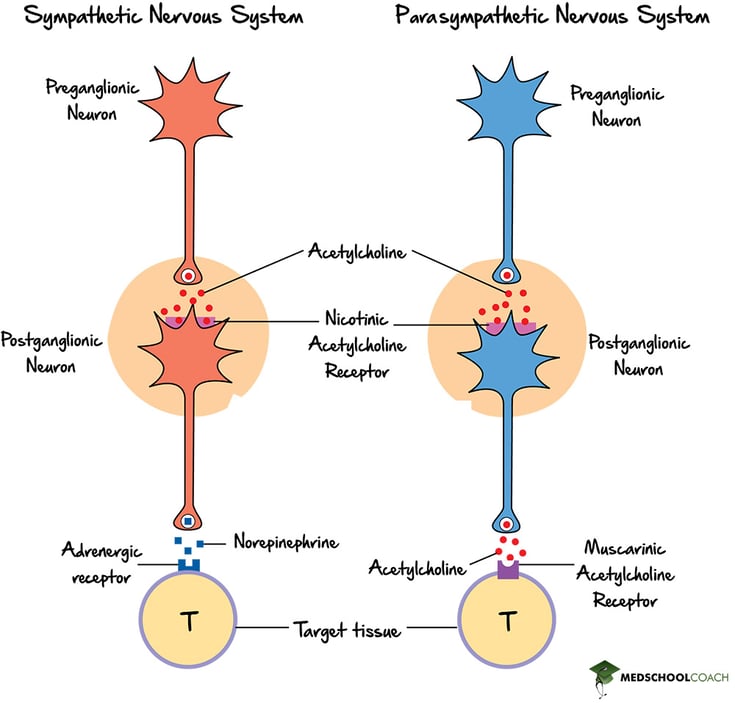Sample MCAT Question - Sympathetic vs Parasympathetic Nervous System
Activation of the sympathetic nervous system results in which of the following physiological changes?
a) Constriction of the bladder
b) Decrease in heart rate
c) Dilation of pupils
d) Stimulation of digestion
Get 1-on-1 MCAT Tutoring From a Specialist
With MCAT tutoring from MedSchoolCoach, we are committed to help you prepare, excel, and optimize your ideal score on the MCAT exam.
For each student we work with, we learn about their learning style, content knowledge, and goals. We match them with the most suitable tutor and conduct online sessions that make them feel as if they are in the classroom. Each session is recorded, plus with access to whiteboard notes. We focus on high-yield topics if you're pressed for time. If you have more time or high-score goals, we meticulously cover the entire MCAT syllabus.
Sympathetic vs Parasympathetic Nervous System
This MCAT post covers the sympathetic and parasympathetic nervous systems, which are the two divisions of the autonomic nervous system. Activation of the parasympathetic nervous system (PNS) produces the “rest and digest” response, whereas activation of the sympathetic nervous system (SNS) results in the “fight or flight” response. These two responses produce largely opposite physiological effects, as discussed below.
Antagonistic Control
The PNS and SNS innervate many of the same target organs. As a result, these target organs are under antagonistic control, in which one system produces an excitatory response and the other system produces an inhibitory response. For example, stimulation of the sympathetic nerves innervating the heart increases heart rate, while activation of parasympathetic nerves in the heart decreases heart rate. Figure 1 depicts the innervation and functions of the PNS and SNS.
Sympathetic Nervous System Activation
The overall function of the SNS is to elicit the “fight or flight” response when a person or animal is exposed to a stressful situation. Activating the SNS increases alertness and mobilizes the body for activity. These effects include dilation of the pupils to facilitate vision, dilation of the bronchi and bronchioles to facilitate breathing, relaxation of the bladder to allow urine to fill, and increased heart rate and vasodilation of blood vessels to skeletal muscles to facilitate motor activity. Simultaneously, the SNS diverts energy away from the digestive system by vasoconstriction of blood vessels to digestive organs.
Parasympathetic Nervous System Activation
The overall function of the PNS is to produce the “rest and digest” response. Activating the PNS is restorative and helps the person or animal conserve energy. The effects of the PNS include constriction of the pupils, constriction of the bronchi and bronchioles, contraction of the bladder for urine release, increased salivation, and increased activity of digestive organs.

Exceptions to Antagonistic Control
Notably, not all organs are innervated by both the SNS and PNS. The SNS exclusively innervates the adrenal medulla to release epinephrine and norepinephrine, the sweat glands to secrete sweat, and the smooth muscle of blood vessels for vasodilation and vasoconstriction. In addition, some important physiological functions require cooperation between the SNS and PNS. For example, erection of the genitals requires parasympathetic activity but orgasm (and ejaculation in men) requires sympathetic activity.
Neurotransmitters of the Sympathetic and Parasympathetic Nervous Systems
As many internal organs receive dual innervation from the PNS and SNS, an interesting question is how the two systems produce different physiological effects. The answer is because of the difference in the neurotransmitters used by each system and the receptors expressed on the target organs.
Both the PNS and SNS involve preganglionic and postganglionic neurons. Preganglionic neurons synapse on postganglionic neurons, which then synapse on the target organ. In the PNS, the neurotransmitter released by both preganglionic and postganglionic neurons is acetylcholine. In the SNS, preganglionic neurons release acetylcholine and postganglionic neurons secrete norepinephrine. Organs innervated by both the PNS and SNS express receptors for both acetylcholine (acetylcholine receptors) and norepinephrine (adrenergic receptors). Different physiological effects are then produced depending on which neurotransmitter is released on the target organ.

Explore More
MCAT Masterclass Chapters
Take a closer look at our entire MCAT Masterclass or explore our lessons below.
-
Nervous System Structure & Function - MCAT Biology
View Subject -
Synapse
View Subject -
Neuron Structure - MCAT Biology
View Subject -
Types of Hormones
View Subject -
The Excretory System & Kidneys
View Subject -
Glial Cells
View Subject




